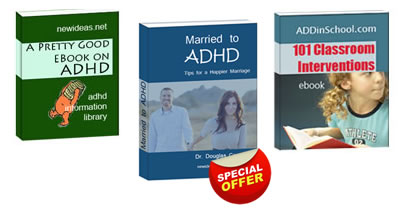ADHD
ADHD is a common diagnosis in children. So, if you are a parent looking for information about ADHD in your child, or teen, or even spouse, please know that you are not alone, and that there is a lot of good information available here on the internet.
ADHD is the abbreviation for Attention Deficit Hyperactivity Disorder. ADHD is one of the most common childhood behavior disorders. Of all children referred to mental health professionals about 35% are referred for ADHD, more than for any other condition. Those with ADHD often have problems in most areas of their life, including life at home, at school, at their job, and in their relationships.
"Attention Deficit Hyperactivity Disorder" is a neurological disorder that impacts somewhere between 5% and 10% of people, young and old. ADHD impacts four main categories:
Attention - causing people to have problems paying attention and focusing on a task, or finishing tasks, especially if they are not very interesting tasks.
Impulsivity - causing a lack of self-control. Impulsive behaviors, or impulsive choices, can cause havoc in relationships, work, school, or life.
Hyperactivity - Many (though not all) with ADHD are "bouncy" and hyperactive, always "on the go" and restless. About 1/2 of all who are diagnosed with ADHD are hyperactive, and the other 1/2 are not.
Easily Bored - Unless the task is very stimulating, like a video game or TV program, or playing outside with friends, those with attention disorders are often easily bored by a task - especially bored by homework, math tests, balancing checkbooks, or doing taxes, and many of these tasks just never get done.
ADHD: Attention Deficit Hyperactivity Disorder
Researchers from the National Institute of Mental Health, part of the National Institutes of Health, talk about the symptoms of ADHD as well as the latest research.
ADHD Impact
Children, teens, and adults can all suffer from ADHD. "Attention Deficit Hyperactivity Disorder" impacts somewhere between 5 percent and 10 percent of children and teenagers, and about 5 percent of all adults. Less than half of children with ADHD ever "out-grow" it in adolescence or adulthood. If untreated, the disorder can have long-term adverse effects into adolescence and adulthood, so we always recommend early and aggressive treatment.
The disorder has different "looks" or "types." For some it severely impacts behavior, and for others it greatly impacts learning. For the group in the middle, it just impacts their attention, focus, concentration, and getting the job done.
Different Types of ADHD in Children
ADHD research literature, recent books, and common sense, all point to the fact that there are different types, or styles, of ADHD. In the past we referred to Attention Deficit Disorder: Inattentive Type, or Impulsive/Hyperactive Type, or a Combined Type. Today the diagnostic differences are a bit less clear, but the reality doesn't change. Even though doctors use the term "ADHD" in every diagnosis, one person with ADHD may have a completely different set of symptoms from another with ADHD.
Some with ADHD are Inattentive, some are Impulsive, and some are Impulsive and Hyperactive. The different "styles" have to do with the different parts of the brain that are impacted by the disorder. There are some common symptoms that each type of ADHD has, and then there are some symptoms that are specific to that particular type of ADHD.
While our observations are based on clinical observations and experiences, they are backed up by recent brain research. For years we have illustrated that there are different types of ADHD to parents and teachers by using the characters of a great children's book : Winnie the Pooh and his friends in the Hundred Acre Wood.
Different Types of ADHD : a closer look
Winnie the Pooh Type ADHD describes those who are inattentive, distractible, and disorganized. They tend to be friendly, but live in a cloud of "brain fog".
Tigger Type ADHD describes those who are inattentive, and also impulsive and hyperactive, restless and bouncy - "because bouncin' is what Tiggers do best!"
Eeyore Type ADHD describes those who are inattentive, but also suffer with a chronic low-grade depression. About 25 percent of those with ADHD also suffer from depression, especially females.
Piglet Type ADHD describes those with ADHD who have trouble shifting attention from one thing to another, worry alot, and are easily startled.
Rabbit Type ADHD describes those who also have trouble shifting attention, but are also inflexible, and can be demanding and argumentative. Though this might describe many teenagers anyway, we are here concerned with children, teens, and adults who have this type of ADHD...
And then there is a Troubled Type ADHD for which there is no character in the Hundred Acre Wood. The Tazmanian Devil from Loonie Tunes is probably a better cartoon character to illustrate this type of ADHD. Those with this style of ADHD tend to be very irritable and perhaps aggressive. They are often impulsive in their aggression. They can be defiant and disobedient. And very commonly have other specific learning problems.
